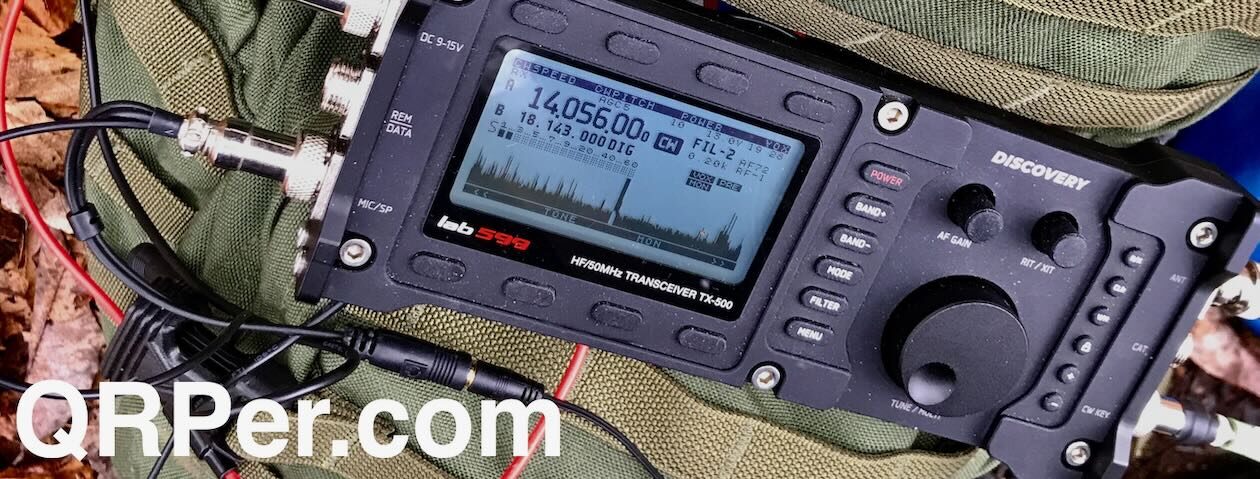A Remote Control Antenna Link
by Dave (KO4YLZ)
Like so many other SOTA activators, I’m constantly tweaking my gear to optimize it for all the variables we encounter in the mountains. One of my main antennas is, of course, an EFHW. Paired with my KX2, I generally get sub-1.6:1 SWR on 40, 20, 15, and 10. However, 30m has an unacceptably high SWR. I considered switching to a multi-link EFHW, but hopping up to change links to chase an inadvertent S2S on another band is inconvenient, especially when the link for low bands is generally well beyond my reach and requires lowering the antenna.
To fully optimize my EFHW I decided I needed to come up with a way to add a “remote” link for 30m. After a couple of design iterations, I came up with the light-weight and compact remote antenna link shown/described below. The version described here is not my final one. While this “pill bottle” version is still quite small, I’d like to reduce the size even further.
Let’s start with the end…
 Here’s the final product. It weighs under 1 oz. and is ~2.5” long. I have included a complete parts list at the end of the article.
Here’s the final product. It weighs under 1 oz. and is ~2.5” long. I have included a complete parts list at the end of the article.
My design considerations were:
- Small and light
- Range of at least 75 ft.
- Reasonable battery life
- Waterproof
- Durable
- Able to withstand the current at the 30m position on the antenna
- Doesn’t adversely impact antenna performance on other bands
- Easy to connect and disconnect from the antenna
Executive Summary
For those in a hurry, here’s a summary description of the remote antenna link. It consists of a very, very small remote control Bluetooth relay powered by two CR2032 batteries (user supplied). A set of contacts (either normally open or closed) lead from the relay to male and female 2mm bullet banana connectors in the cap of the pill bottle. Two matching bullet banana connectors at the antenna plug into the remote control link.
To operate, you simply open the bottle, switch on the batteries, re-install the cap, extend the antenna, and plug the bullet banana connectors at the antenna into the opposite pair embedded in the cap of the pill bottle. When you are ready to operate, you just push the remote button. When the remote button is pushed, the relay opens or closes thereby making or breaking the link and physically shortening or lengthening the antenna. Below is a picture of both sides of the mini-relay (antenna wire not shown)
The relay can run on 3.5-12 volts and can handle 1A. The included 1-button transmitter sends a signal (455mHz) to the relay and either opens or closes a set of contacts depending on how the user programs the relay.
Wiring It Up
I won’t bore you with a detailed written explanation…it’s a pretty simple build. Below are a simple wiring diagram and a series of photos with build details [click images to enlarge].
Making It work
The relay has three operating modes: latched, momentary, and toggle. Because I wanted the 30m link to be normally connected when the relay is in standby waiting for a signal from the remote control and open and stay open when I pressed the remote button, I had to reprogram the relay. Programming is accomplished by turning the unit on, then putting a 22ga wire jumper between the two “programming dots” and then pressing the remote button until the LED on the relay board flashes the number of times specified in the instructions for the operating mode you want. The instructions are not very clear, so I recommend connecting the unit to your VOM in continuity mode to figure out the button/LED flashing sequence that corresponds to how you want the relay to behave.
Testing
The unit is rated for 1A so, to be sure I wasn’t going to blow it up when I transmitted with 10 watts, I used ChatGPT to produce a very nice graph showing the current at the 30m position on the antenna for each band when transmitting with 10W. Here’s the graph. Luckily, the maximum current at the 30m position (~43’) is .6A at 7.062 MHz.
I tested the unit on my KX2 by setting my operating frequency and then putting the KX2 tuner in bypass mode and pressing the button on the remote control; Ding…the SWR jumped immediately to the expected pre-determined (and acceptable) SWR value for the 30m band!
The unit draws 7mA when in standby and 32mA when the relay is energized. Assuming 40 minutes of operating off of the 30m band (relay not energized) and 20 minutes on the 30m band (relay energized), I calculated that approximately 17mA would be drawn from the two CR2032 batteries. Given that a CR2032 battery has a capacity of 220mAh, they should provide about 12 hours of operation.
Any questions, please comment.
Dave – KO4YLZ
Parts List
Note: The Amazon links above are affiliate links that supports QRPer.com at no cost to you.

















